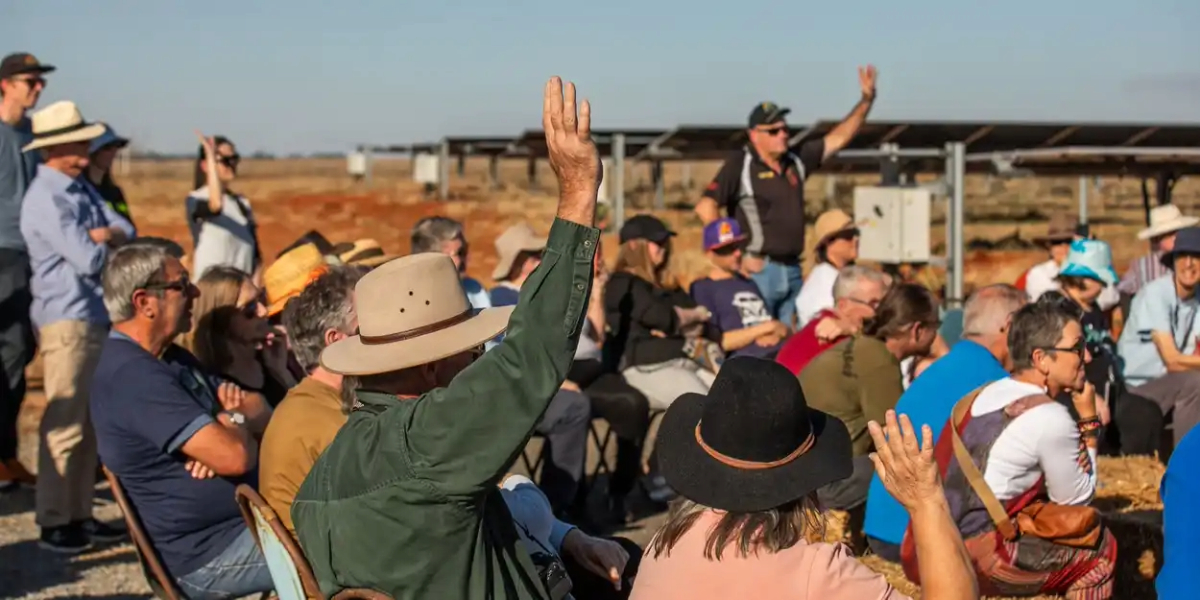Regional communities hosting renewable energy projects are being urged to think beyond painting the town hall and footy jerseys and take the lead in securing long-term social, economic and environmental benefits from the renewable transformation.
Community benefit sharing programs are a strategy to ensure renewable energy projects contribute to the wellbeing and future of the regions that host them. The Clean Energy Council estimates these benefit sharing contributions will be worth $213 million by 2030, growing to $1.9 billion by 2050.
The Guide to Regional Benefit Sharing released by Community Power Agency offers a blueprint for coordinating and amplifying the benefits that flow from the energy transition.
While community benefit sharing has traditionally taken the form of small, ad hoc grants from individual projects, the guide advocates for a coordinated, community-led approach that aligns with regional priorities and delivers transformative outcomes.
“We only need to paint the town hall so many times,” said Kim Mallee, Director of Community Power Agency.
“Energy projects bring real investment into regional areas, but without coordination, we risk wasting the opportunity.”
The guide provides practical tools for pooling resources from multiple renewable energy developments, reducing community consultation fatigue, and creating what Mallee calls “legacy-scale” outcomes like social housing, education pathways or health infrastructure.
“This is our chance to get it right with regional communities leading the way,” she said.
For Claudia Hodge, Project Manager at Community Power Agency and co-author of the guide, the goal is simple: stop communities from competing for small grants and start thinking strategically. “This guide shows how pooling resources across projects, and empowering communities to manage those resources, can open up new possibilities for greater, longer-lasting outcomes,” she said.
“We hope this guide will inform how councils and community groups in the New England region structure their benefit-sharing programs,” Hodge said.
“It’s about designing a process that builds on what’s already been done locally and empowers communities to develop their own strategic vision.”
Rather than each small organisation scrambling for small grants, the guide recommends a collaborative model where communities identify shared priorities and coordinate how multiple energy developers contribute to them.
Ideas for better community benefit sharing
- Pooling resources: Encouraging multiple energy developers to direct part of their benefit-sharing funds into a central regional fund, which can then support larger, long-term projects.
- Community-led planning: Supporting communities to develop strategic plans that set clear regional priorities, which developers can align their contributions to.
- Flexible governance structures: Choose from options ranging from simple memorandums of understanding between developers and councils to the establishment of dedicated legal entities, such as not-for-profits or community foundations, that manage funds and deliver programs.
- Layered representation: Ensuring councils have a seat at the table without dominating the process, and including strong representation from grassroots community organisations.
- Reducing engagement fatigue: Minimising the burden on communities to repeatedly participate in consultations for each new project, by coordinating engagement efforts and building on existing strategic work.
Importantly, the guide recognises the variation in trust and capacity between local councils across the country. Where confidence in council is low, the guide suggests mechanisms for community groups to play a more direct role in governance, with models ranging from informal MOUs and advisory committees to new legal entities like local foundations or cooperatives.
“Just because council negotiates the benefit-sharing agreement doesn’t mean they should hold the funds or control where they go,” Hodge said.
The guide also addresses the issue of growing engagement fatigue in some regions.
“Communities are being asked to consult again and again on one project after another, and their individual benefit sharing initiatives. Strategic coordination helps reduce that burden, gives people a stronger voice, whilst minimising engagement fatigue,” said Mallee.
The Community Power Agency is hosting a webinar on Tuesday, 22 July, to explore the guide in more detail and hear from other regions already experimenting with regional coordination. To join the public webinar on Tuesday, 22 July, from 1:00 to 2:15pm (AEST) – register here.
Read all the way through to the end of the story? So did lots of other people. Advertise with New England Times to reach New England locals who are interested and engaged. Find out more here.

